Header logo
header top contact widget
Financing Options
Healthy Gums Advantageous To A Healthier YOU!
Posted on Apr 22, 2024 by William J. Claiborne, DDS MS
Periodontal (gum) disease and subsequent tooth loss has damaging effects to an individual, far beyond the mouth. When this was suspected decades ago, it prompted national agencies to track the oral health of the U.S. population. Using this extensive data, studies have revealed some interesting statistics, including how various age groups fare when it comes to oral wellness.
The following is mostly information pulled from the National Institutes of Health’s (NIH) “Oral Health In America” report. Released in December 2021, the findings were the culmination of years of research assembled by more than 400 contributors.
On a positive note, the percentage of Americans who have experienced tooth loss has declined since the 1970’s. As of 2016, complete tooth loss has fallen by more than 75% for adults between the ages of 65 – 75 years. Unfortunately, there is not good news when it comes to tooth decay – for nearly any adult age group.
For adults between the ages of 20 – 64, cavities have affected 90% and gum disease exists for nearly 50% of adults aged 45 – 64 years. This should be a concern for every American. This is because research has determined that the bacteria of periodontitis (advanced gum disease) can trigger or worsen a long list of serious health problems.
The list includes:
• Stroke
• Coronary Artery Disease
• Arthritis
• Diabetes
• Preterm & low birth weight babies
• Some Cancers (including oral and pancreatic)
• Alzheimer’s disease
• Impotency, Erectile Dysfunction (ED)
• Prostatitis (elevated PSA levels)
In addition to poor oral hygiene routines at home and avoiding regular dental cleanings and exams, high-risk behaviors (such as use of tobacco, opioids, and alcohol) accentuate the risks of gum disease.
Although gum disease can begin without obvious signs or symptoms, the most commonly noticed are:
• Red, swollen or tender gums
• Seeing blood in the sink when brushing
• Receded gums
• Loose or separating teeth
• Pus pockets on gum tissues
• Sores in the mouth
• Persistent bad breath
While the report found that there are stark differences in adult groups who had less access to having regular oral health care, disparities also stem from underlying economic, demographic, and societal inequities.
Below are some of the oral health variations pertaining to certain groups.
ADOLESCENTS
During the past 20 years, the percentage of adolescents (ages 12 − 19) having at least one molar with a sealant applied has nearly tripled, from 18% to 48%. That’s a good thing. Even so, there has been no decline in untreated tooth decay in adolescents since the last surgeon general’s report twenty years ago.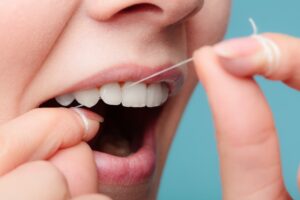
High caries (cavities in teeth) experienced in early childhood is the strongest indicator of caries problems that will be experienced in adolescence and adulthood. This means that when the factors contributing to developing cavities in childhood persist, the incidence of caries affecting permanent teeth will continue to increase during adolescence. Likewise, misalignment of teeth that exist or develop during adolescence can substantially impact eating, speech, gum health, and even psycho-social development. (Imagine a teen with teeth so mispositioned that they are ridiculed by peers.)
OLDER AMERICANS
There is good news for our older population (Americans over the age of 65). Their overall oral health has significantly improved over the past two decades with fewer teeth being extracted. Additionally, the proportion of the population with edentulism (no remaining natural teeth) is at an all-time low.
The not-so-great news… tooth loss remains a problem for older adults. Today, 1 in 6 Americans have no remaining natural teeth. At this rate, by the year 2030 (just 6 years from now), the 65-&-over age group without teeth will increase to 1 in 5.
For adults over the age of 75, the challenges are even greater. Over 54% have fewer than 21 remaining teeth with the number increasing to 80% for those living in poverty. With age also comes the increased prevalence of systemic diseases that may impact the mouth, making older adults more susceptible to oral health issues. (This includes heart disease, diabetes, arthritis, etc.)
Fortunately, things are moving in a positive direction for older adults, with more keeping their teeth than any previous generation. This has largely been the result of having increased attention on the benefits of prevention and improvements in treatments for gum disease and cavities, along with a decrease in the rate of smoking. (About 8 of every 100 adults – 8.3% – of adults 65 years and older were reported to smoke in 2023.)
WOMEN
Women have unique oral health concerns due to changing hormone levels based on menstrual cycles, pregnancy, and menopause. These fluctuations can raise the risk of oral problems that effect teeth or gums. Health issues, such as diabetes, can also affect the oral health of females.
To keep your teeth healthy, it is important to remove dental plaque. This is a sticky, colorless film of bacteria that coats teeth and gums. Plaque buildup can cause tooth decay and gum disease.
Even teeth that already have fillings are at risk for tooth decay. Plaque can build up underneath a chipped filling and cause new decay. And if there are areas in your mouth where your gums have pulled away from the teeth (known as receded gums or gum recession), the exposed tooth roots can decay as well.
It’s important – for all ages – to be committed to their oral hygiene time at the sink, at least twice a day. Devoting these minutes to the care of your teeth and gums will pay off in future years, helping to minimize costs for dental repairs and time in treatment. And, when early ages get into the habit of an oral care routine at home, they are more likely to carry that into adulthood.
Here are some easy brushing tips:
• Use fluoride toothpaste, which is an ingredient of many products. Fluoride protects teeth from cavities, helping to strengthen the tooth’s hard outer surface – the enamel.
• Angle the bristles toward the gumline so they can sweep away bacteria between the gums and teeth.
• Brush gently using small, circular motions. Do not scrub hard back and forth, which can wear down tender gum tissues and wear away tooth enamel.
• Brush all sides of each tooth and the tops (where debris and bacteria can hide within grooves).
• Brush your tongue, especially towards the back where the majority of bacteria embed. Swish well with water at least twice afterwards.
Cleaning between teeth to remove plaque is also part of a good oral hygiene routine. If plaque is not removed, some of it can harden below the gum line and irritate the gums. The gums become red, swollen, and may bleed easily. These are signs of gingivitis. Gingivitis caused by plaque buildup is a mild form of gum disease, and you can usually reverse it with daily brushing and flossing.
If plaque stays on your teeth for too long, it can harden. This hardened plaque is called calculus, or tartar. The only way to remove tartar is to have your teeth cleaned by a dentist or dental hygienist. If the tartar is not removed, the gingivitis can get worse and lead to more severe gum (periodontal) disease. In advanced stages, gum disease causes sore, bleeding gums; painful chewing problems; loose teeth; and even tooth loss.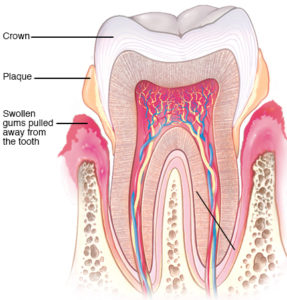
Here are some additional ways to keep a healthy smile with practical measures.
- Floss to remove plaque, and food particles, from between your teeth.
- Visit the dentist for routine check-ups and professional cleaning. If you are at a high risk for tooth decay (for example, if you have a dry mouth because of medicines you take), your dentist or dental hygienist may give you a fluoride treatment, such as a varnish or foam during the office visit.
- Drink fluoridated water. Drinking water with the right amount of fluoride protects your teeth throughout the day.
- Don’t smoke. Smoking increases your chance of gum disease. If you smoke and want to quit, there are many resources to help you: FDA’s Center for Tobacco Products, CDC’s Quit Smoking website, and the BeTobaccoFree.gov website.
- If you are planning to become pregnant, have a dental checkup. Because of hormonal changes, pregnant women may develop gingivitis and experience gums that are swollen and bleed easily. During pregnancy, it is especially important to practice good oral hygiene to maintain the health of your gums.
- Eat a diet that is low in sweets and sugary drinks.
A periodontal specialist is your best advocate in restoring or maintaining healthy gums. In addition to the skills in treating all stages of gum disease (from gingivitis to periodontitis), a periodontist specializes in the selection and placement of dental implants.
If you have signs or symptoms that may be indicative of gum disease, please know this disease will only worsen without treatment. Call 828-274-9440 to schedule an appointment or ask to begin with a consultation.
If dental fear is a concern, we can discuss oral or IV sedation options. These are administered safely with skilled staff members who use advanced safety equipment throughout your care.
Additionally, if you’ve delayed care due to cost, we office several payment plans that many patients find helpful. These plans can break costs into monthly payments, often with no down payment required.
Sources:
https://www.nidcr.nih.gov/health-info/oral-hygiene
https://www.nidcr.nih.gov/research/oralhealthinamerica/section-2b-summary
https://www.nidcr.nih.gov/research/oralhealthinamerica/section-3b-summary
https://www.nidcr.nih.gov/research/oralhealthinamerica/section-3a-summary
https://www.womenshealth.gov/a-z-topics/oral-health
https://www.cdc.gov/tobacco/data_statistics/fact_sheets/adult_data/cig_smoking/index.htm
Reshaping Gum Tissues To Protect Oral Health & Enhance Smiling Appearance
Posted on Mar 21, 2024 by William J. Claiborne, DDS MS
When people think about the appearance of their smiles, it’s typically the teeth that are the focus. Everyone wants a smile that enhances appearance, instills self-confidence and gets compliments. Yet, the appearance of a smile involves more than just teeth. The “frame” of gum tissues that arch the teeth most visible in a smile have a lot to do with how a smile looks.
As a periodontal specialist in Asheville, NC, part of my specialty involves the treatment of all stages of periodontal (gum) disease, the placement of dental implants, and the contouring of gum tissues. Gum contouring is generally done for esthetic reasons but may also be advised for oral wellness.
Gums most often pull away from the base of teeth (or “recede”), exposing darker areas of the tooth. This darker area is part of the tooth’s root and highly vulnerable to damage. Recession also causes teeth to look longer and expose darker tooth root areas of the tooth. Being sensitive to hot or cold – causing a sudden jolt of pain – is often the final warning sign that the gums are not protecting tender root segments of the tooth.
Gum recession is commonly due to:
• Gum disease, which destroys gums tissues, causing them to loosen their firm grip around the base of teeth. This enables oral bacteria to penetrate beneath the gum line, reaching vulnerable bone and tissues.
• Over-vigorous toothbrushing can wear away precious gum tissues that surround the base of teeth. When using a back-&-forth scrubbing motion, or a hard toothbrush, gum tissues can be scrubbed off. Too, using abrasive substances to brush (such as baking soda) not only wear down gum tissues, they wear away tooth enamel.
• The aging process lessens hydration in the body. Because the gum tissues are moist layers that require continual hydration (supported by saliva), oral dryness can cause the gums to draw up as they become drier. Unfortunately, this creates more challenges in maintaining healthy teeth.
While gum recession is an oral health concern, it is a cosmetic issue as well. For an attractive smile, teeth should be arched by a balanced level and shape of gum tissues. When there is too much gum tissue showing above teeth or varying heights of gums arching teeth, the height and symmetry of gum tissues can be corrected by a periodontist.
For example, in a gummy smile, too much of the gum line is visible. This makes teeth look short and draws the eye to the gums rather than the teeth. Gum tissues should complement teeth with a balanced line of gum tissues. While a gummy smile is not generally problematic for one’s oral health, many people find it makes them “hold back” on smiling fully.
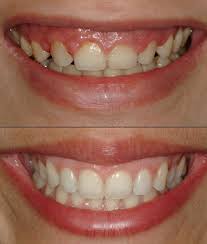
Before & After Of A Gummy Smile
The procedure to correct a gummy smile is a gingival lift, also known as a gum lift or gum contouring. This in-office procedure is performed to reduce and reshape highly visible gums.
In our Western NC periodontal dental office, we use a dental laser to perform a gingival lift. Our dental laser gives a precision line while only removing specific areas of the gums, leaving all surrounding tissue unharmed. This allows us to reshape the gums to create better balance in the smile.
A laser gingival lift also offers patients a more comfortable experience since it causes very little pain and therefore requires only topical anesthesia. In addition, laser treatments result in almost no bleeding and tissues tend to heal more quickly than after traditional surgery.
We also perform gum grafting that recovers areas where gum recession has occurred. This helps to protect the tooth roots and improves the appearance of the smile.
In gum grafting, we normally take a small area of tissue from the roof of the mouth and place it in the area of recession. When there is not sufficient tissue available, a graft may be from a donor source. The graft is attached to the natural gum tissue and gently sutured into the position where it corrects a smile’s appearance and reduces further recession and the potential for gum disease.
Several teeth may be involved in gum grafting when used to even out the gum line or reduce the risk of gum and bone collapse after a tooth has been lost. In these cases, cosmetic gum surgery is beneficial in reshaping excess gum and bone tissue. It also reduces sensitivity from exposed roots to hot or cold foods.
As a periodontist, I most commonly see gums that cover too much of the teeth as being due to genetics. When gums fail to cover sufficiently over the base of teeth, it’s typically the cause of recession, which can occur from several reasons (as listed prior). Regardless of why it has occurred, our goal is to provide the patient with the most healthy and esthetic outcome in a procedure that is comfortable, successful, and requires minimal healing time.
In our Asheville periodontal dental office, we offer some of the most advanced dental technology available. In addition to amazing imaging, such as Cone Beam 3D imaging, we provide Laser-Assisted New Attachment Procedure (or LANAP). This is a cutting-edge protocol to more efficiently and effectively treat periodontitis (advanced gum disease) with the PerioLase® MVP-7™ laser. Treatment is minimally invasive and helps to minimize both discomfort and recovery time. It has also been found to stimulate bone regrowth in damaged areas.
Additionally, our office offers both oral and I.V. sedation (“twilight sleep”) for complete relaxation during treatment. Sedation is administered safely by a doctor of anesthesia to provide optimal safety and comfort.
If finances have kept you from seeking out the care you need or the beautiful smile you desire, feel free to contact our friendly staff and arrange a consultation appointment. During this time, we can discuss the best options for you, cost estimates, and predicted treatment time.
We can also review several payment plans that make treatment affordable through extended, interest-free payment periods with no down payment required. These often help our patients enjoy their confident, new smiles while making easy monthly payments that are budget friendly.
Call 828-274-9440 to schedule.
How A Periodontist Can Help Cancer Patients
Posted on Mar 18, 2024 by William J. Claiborne, DDS MS
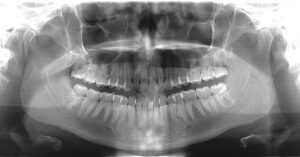
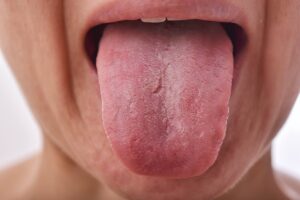
Dental Implants – Advantages of Specialized Skills, Advanced Technology, Optimal Comfort
Posted on Jan 10, 2024 by William J. Claiborne, DDS MS
It wasn’t that long ago when shopping for Christmas presents was quite the time-consuming ordeal. Today, we do searches for gift ideas online, check price comparisons, and have the items show up on our doorstep within a day or so.
Advancements through computerized technology have things running more efficiently and, in many cases, culminate into superior outcomes. This is true in dentistry, especially for those who opt for dental implants to replace missing teeth.
There are many reasons for people to choose dental implants, including:
– Designed to last a lifetime
– Look, feel and function like natural teeth
– Won’t decay or need repairs
– Restore chewing and biting comfort and stability
– Enhance overall health and confidence
– Halt the process of facial bone loss
Occasionally, dental implants are occasionally offered by general dentists. As a periodontist, however, I am referred most of our dental implant patients by other dentists and dental specialists. This is because a periodontist has advanced education and skills in the diagnosis and treatment of all areas of the tissues in the mouth (including the reshaping of gum tissues).
Periodontists are also specialists when it comes to the diagnosis and placement of dental implants. They are trained to understand the intricate concepts involved in selecting the proper type of implant based on each individual. These skills include the understanding of precision placements of implants at proper depths and angles. Additionally, periodontists are able to optimize your comfort and treatment outcome.
Still, another reason we are referred patients for dental implants because we can offer patients a wider variety of choices when it comes to implant systems.
There are many types of dental implants. Various systems are designed to support one replacement tooth (the “restoration”), a bridge of two or more teeth, or a full denture supported by several strategically-placed implants. Understanding the unique advantages of all systems enables us to choose the best type for the patient’s individual needs and goals.
For example, the All On Four dental implant system is designed to support non-removable teeth on just 4 implants (per arch). With its specially-designed implanted portions, these longer implants can fully distribute biting and chewing forces.
All-On-4 is an ideal choice for people who have lost bone mass due to lengthy periods of tooth loss. Because “All On 4” implants can be placed in minimal bone, many patients are able to avoid the need for bone rebuilding procedures prior to traditional implant placement.
In the placement, a periodontist is also the best “go-to” in dental implant skills. Here’s why…
For a dental implant to serve as a lasting tooth replacement system, it must be positioned in the jaw bone to specific depths and angles. An implant that is wrongly positioned can function less efficiently and lead to the need for removal.
For example, a periodontist can incorporate bone rebuilding procedures into treatment to a proper depth for patients missing a great deal of bone mass (typically due to missing natural teeth for many years). This can help to restore bone that has occurred in the mandible (lower jaw) or maxilla (upper jaw), which may also require a sinus lift.
Another example is a patient who has lost teeth due to periodontal (gum) disease. Because a periodontist combines advanced skills in treating gum disease as well as in dental implants, these patients have an added advantage when it comes to treatment success.
When it comes to the best way to pinpoint and tackle specific issues with our health, it makes sense to see a doctor who has received specialized training in that area. This helps to take the guesswork out of diagnosis and enhances the potential for a successful outcome in an efficient process.
A periodontist also has a reputation for being able to optimize patient comfort. Because a periodontal specialist is uniquely skilled in the care of gum tissues, he or she can provide a conservative approach to the placement process. Through respectful treatment of oral tissues (in both placement and exposure for restorations), less disruption to the gums allows for faster healing and higher comfort levels.
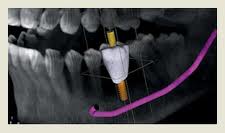 In our Western NC periodontal dental office, we incorporate our care with the advantages of some of the most advanced technology in dentistry; many options which are not readily available in other dental offices in our region. These computerized images offer advantages to patients in helping to minimize treatment needs.
In our Western NC periodontal dental office, we incorporate our care with the advantages of some of the most advanced technology in dentistry; many options which are not readily available in other dental offices in our region. These computerized images offer advantages to patients in helping to minimize treatment needs.
These include:
- LANAP (Laser-Assisted New Attachment Procedure) with PerioLase MVP 7 – an advanced protocol that efficiently and effectively treats advanced gum disease with the added advantages of a dental laser. This offers a non-surgical alternative for patients with moderate to severe periodontal disease and has even been found to stimulate bone regrowth in damaged areas.
- Cone Beam Imaging – is ideal for diagnoses and treatment planning through images that provide a clear view of the upper and lower jaw (including nerve canals), with rotations that show sagittal, axial, and coronal planes in a process that is quick, painless and at minimal radiation levels.
- CareStream Cone Beam Computer Tomography Imaging – is enhanced tomography that works with 3D imaging for exceptional detail and range.
- CS 3600 Intraoral Scanner – quickly and comfortably captures digital impressions to create precision models or appliances accurately and easily (crowns, inlays, onlays, bridges, orthodontic appliances, aligners, custom abutments) without the need for bulky, goopy trays.
- Computerized Dental Implant Placement – an advanced system for pre-surgical positioning of dental implants using a 3D model of the patient’s jaw. Once the implant type is selected, a template is developed for optimal treatment success.
For optimal comfort, we offer several sedation options, including oral and IV sedation. Oral sedation is a pill that helps patients relax. It also has an amnesiac effect, leaving most with little or no memory of treatment afterward. I.V. sedation (also known as “twilight sleep”) places the patient in a deeper sleep state and erases memory of the procedure. It is administered by a doctor of anesthesiology for optimal comfort and safety.
In our Western NC periodontal dental office, anesthesia is overseen by a Medical Doctor (MD) who is a board certified Anesthesiologist. With both sedation options, patients are closely monitored with advanced safety equipment throughout treatment.
Our goal is to help people move forward with treatment affordably for enhanced appearance, self-confidence and sense of security.
For those who have bypassed dental implants because of cost, our payment plans are often able to help patients enjoy the benefits of their dental implants without straining their budget. Most of these payment plans require no down payment, are interest-free, and have no prepayment penalty.
If you’ve considered dental implants in the past but have held back because of obstacles that may actually be overcome, begin by calling our Asheville periodontal dental office and speaking to our friendly staff at: 828-274-9440. Many dental implant patients find they were able to achieve the healthy smile they desired once they consulted with us and learned the options based upon their individual needs.
Recent Posts
Categories
Archives
- September 2024
- August 2024
- July 2024
- June 2024
- May 2024
- April 2024
- March 2024
- February 2024
- January 2024
- December 2023
- November 2023
- October 2023
- September 2023
- August 2023
- July 2023
- June 2023
- May 2023
- April 2023
- March 2023
- February 2023
- January 2023
- December 2022
- November 2022
- October 2022
- September 2022
- August 2022
- July 2022
- June 2022
- May 2022
- April 2022
- March 2022
- February 2022
- January 2022
- December 2021
- November 2021
- October 2021
- September 2021
- August 2021
- July 2021
- June 2021
- May 2021
- April 2021
- March 2021
- February 2021
- January 2021
- December 2020
- November 2020
- October 2020
- September 2020
- August 2020
- July 2020
- June 2020
- May 2020
- April 2020
- March 2020
- February 2020
- January 2020
- December 2019
- November 2019
- October 2019
- September 2019
- August 2019
- July 2019
- June 2019
- May 2019
- April 2019
- March 2019
- February 2019
- January 2019
- December 2018
- November 2018
- October 2018
- September 2018
- August 2018
- July 2018
- June 2018
- May 2018
- April 2018
- March 2018
- February 2018
- January 2018
- December 2017
- November 2017
- October 2017
- September 2017
- August 2017
- July 2017
- June 2017
- May 2017
- April 2017
- March 2017
- February 2017
- January 2017
- December 2016
- November 2016
- October 2016
- September 2016
- August 2016
- July 2016
- June 2016
- May 2016
- April 2016
- March 2016
- February 2016
- January 2016
- December 2015
- November 2015
- October 2015
- September 2015
- August 2015
- July 2015
- June 2015
- May 2015
- April 2015
- March 2015
- February 2015
- January 2015
- December 2014
- November 2014
- October 2014
- September 2014
- August 2014
- July 2014
- June 2014
- May 2014
- April 2014
- March 2014
- February 2014
- January 2014
- December 2013
- November 2013
- October 2013
- September 2013
- August 2013
- July 2013
- June 2013
- May 2013
- April 2013
- March 2013
- February 2013
- January 2013
- December 2012
- November 2012
- October 2012
- September 2012
- August 2012
- July 2012
- June 2012


